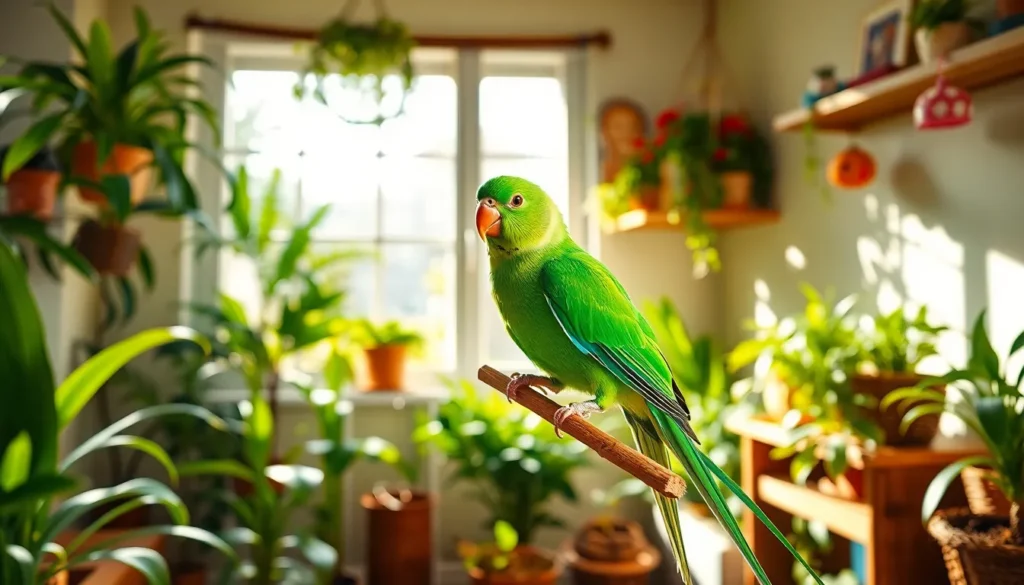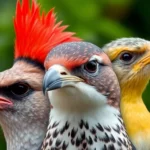We’ve all seen those vibrant little birds with their cheerful chatter and playful personalities gracing pet stores and living rooms across America. Parakeets – those delightful feathered companions that’ve captured millions of hearts – aren’t just pretty faces in the bird industry. They’re intelligent social creatures that can transform your home into a lively sanctuary filled with color and conversation.
Whether you’re considering adding one to your family or you’re simply curious about these remarkable birds we’ll explore everything that makes parakeets such extraordinary pets. From their fascinating wild origins to their surprising ability to mimic human speech these small parrots pack tremendous personality into their compact frames.
What Is a Parakeet Bird?
Parakeets are small to medium-sized parrots belonging to the order Psittaciformes, characterized by their long tail feathers and vibrant plumage. These intelligent birds originate from tropical and subtropical regions across Australia, South America, Africa, and Asia.
Different Species of Parakeets
Over 115 species of parakeets exist worldwide, each displaying unique characteristics and colorations. Budgerigars represent the most common parakeet species in captivity, measuring 7 inches in length with their distinctive yellow and green striped patterns. Monk parakeets build large communal nests and adapt well to urban environments across multiple continents. Indian ringneck parakeets showcase brilliant green bodies with distinctive neck rings in males, reaching lengths of 16 inches including their elongated tails.
Rose-ringed parakeets demonstrate remarkable adaptability, establishing wild populations in cities like London and San Francisco. Alexandrine parakeets rank among the largest parakeet species, growing up to 23 inches with striking red shoulder patches and oversized beaks. Blue-crowned parakeets display predominantly green bodies with distinctive blue head crowns, while their loud calls make them easily identifiable in their South American habitats.
Physical Characteristics and Size
Parakeet birds typically measure between 7 to 18 inches in length, with their distinctive long tails comprising nearly half their total body length. Most parakeets weigh between 1 to 5 ounces, making them lightweight yet sturdy companions for pet enthusiasts. Their curved beaks adapt perfectly for cracking seeds and nuts, while their zygodactyl feet feature two toes facing forward and two backward for enhanced gripping ability.
Vibrant green dominates most parakeet species’ base coloration, though selective breeding has produced variations including blue, yellow, white, and pied combinations. Males often display more pronounced coloring and distinctive markings compared to females, particularly evident in species like the Indian ringneck where males develop prominent neck bands. Their compact bodies feature strong flight muscles beneath sleek feathers, enabling swift and agile movement through trees and open spaces.
Parakeet eyes range from dark brown to bright orange depending on the species, while their small nostrils sit prominently above their beaks. Their lifespan varies significantly across species, with budgerigars living 5 to 10 years and larger parakeets like Alexandrines reaching 20 to 30 years in proper care conditions.
Parakeet Bird Behavior and Personality
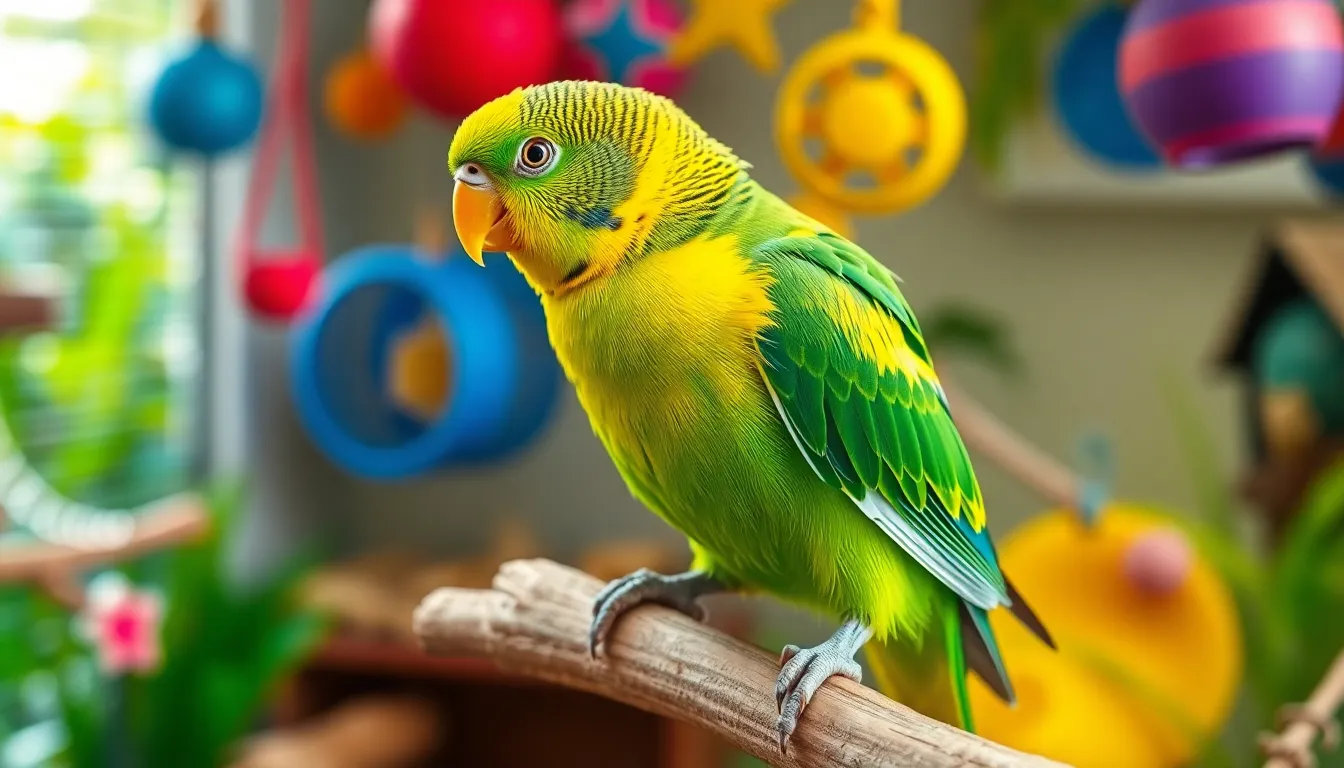
Parakeet birds display complex behavioral patterns that make them fascinating companions for bird enthusiasts. These intelligent creatures demonstrate remarkable social skills and cognitive abilities that set them apart from many other pet birds.
Social Nature and Communication
Parakeet birds are inherently social creatures that thrive in group environments. Wild parakeet flocks consist of hundreds to thousands of individuals that communicate through a sophisticated system of vocalizations, body language, and social hierarchies.
Budgerigars produce over 20 distinct calls including contact calls, alarm calls, and territorial vocalizations. These birds establish strong pair bonds and engage in mutual preening behaviors that strengthen social connections. Captive parakeets often view their human caregivers as flock members and actively seek interaction through chirping, head bobbing, and wing flapping.
Communication methods extend beyond vocalizations to include visual displays. Parakeets raise their head feathers when excited, lower their heads to request preening, and perform elaborate mating dances during breeding season. Single parakeets in captivity may develop behavioral issues like excessive screaming or feather plucking due to their strong social needs.
Indian ringneck parakeets demonstrate particularly advanced communication skills by learning human words and phrases with remarkable clarity. Monk parakeets create complex social structures within their large communal nests, with individual birds maintaining exact roles within the colony.
Intelligence and Learning Abilities
Parakeet birds possess cognitive abilities that rival those of much larger parrot species. Research studies show that budgerigars can learn sequences of up to 8 different actions and remember these patterns for extended periods.
Problem solving capabilities include opening cage latches, manipulating puzzle toys, and learning cause and effect relationships. Parakeets demonstrate object permanence by continuing to search for hidden food items and recognizing themselves in mirrors after extended exposure.
Learning capacity varies significantly among parakeet species. Alexandrine parakeets master vocabularies of 50 to 100 words, while budgerigars typically learn 10 to 20 words with consistent training. These birds respond to positive reinforcement training methods and can learn tricks like stepping onto fingers, flying to designated perches, and retrieving small objects.
Memory retention in parakeets extends beyond immediate training sessions. Studies indicate that parakeets remember learned behaviors for 6 to 12 months without practice. Young parakeets between 3 to 6 months old show optimal learning potential, though adult birds continue developing new skills throughout their lives.
Foraging intelligence appears in captive parakeets through their ability to locate hidden food sources and manipulate complex feeding devices. Wild parakeets demonstrate seasonal migration patterns that require sophisticated navigation skills and environmental awareness.
Housing Requirements for Parakeet Birds
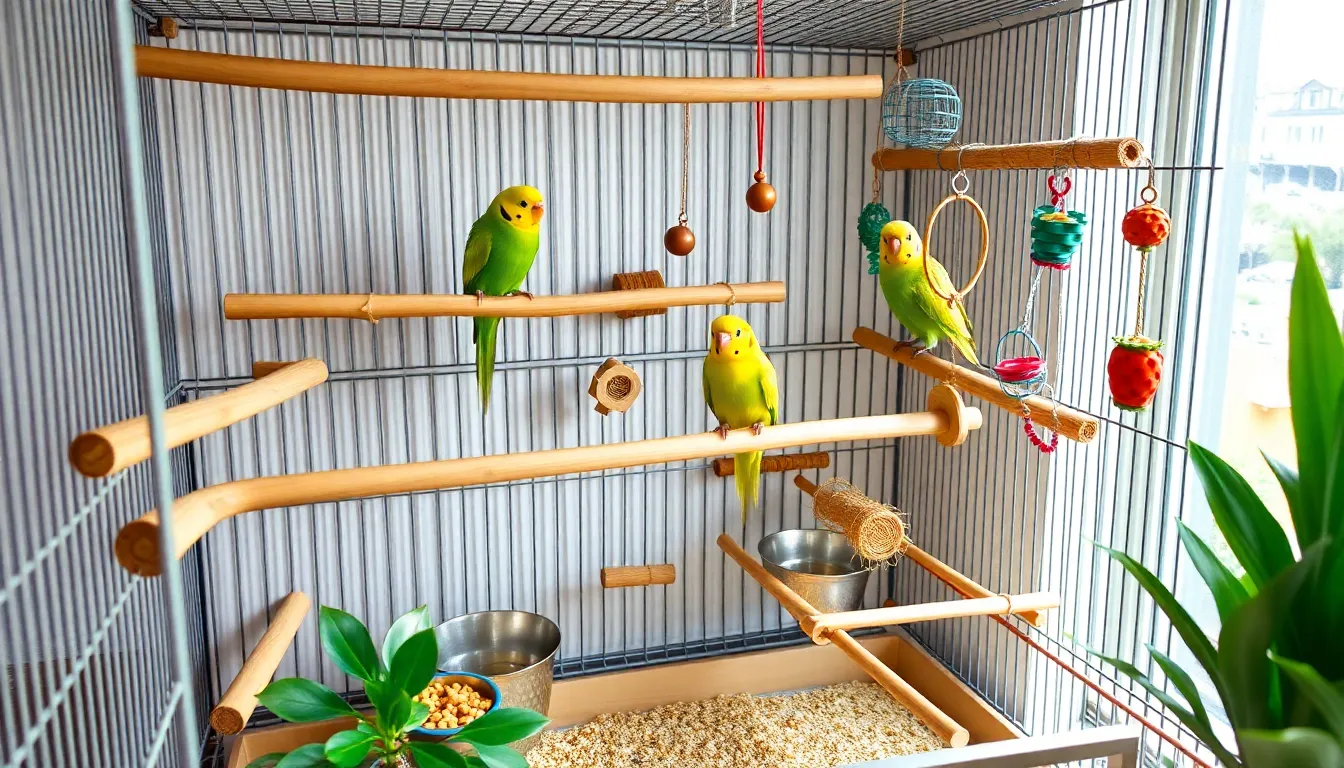
Creating proper housing for parakeet birds forms the foundation of their physical and mental wellbeing. We must provide environments that accommodate their natural behaviors while ensuring safety and comfort.
Cage Size and Setup
Minimum cage dimensions for budgerigars start at 18 inches wide by 18 inches deep by 18 inches high for single birds. Larger parakeet species like Alexandrines require cages measuring at least 32 inches wide by 23 inches deep by 39 inches high. Width takes priority over height since parakeets fly horizontally rather than vertically in their natural habitats.
Bar spacing specifications vary by species size to prevent injury or escape. Budgerigars need bar spacing between 0.4 to 0.6 inches while larger species require 0.6 to 0.8 inches. Horizontal bars on at least two cage sides provide climbing opportunities that mirror their natural perching behaviors.
Perch placement throughout the cage encourages movement and exercise. Natural wood branches from apple cherry or willow trees offer varying diameters that promote foot health. We position perches at different heights and angles avoiding direct lines between food water and perches to prevent contamination.
Food and water station setup requires stainless steel or ceramic bowls placed away from perching areas. Two separate feeding stations prevent competition between paired birds and ensure continuous access to nutrition. Water bottles often work better than open bowls since they stay cleaner longer.
Toy rotation every 7 to 10 days prevents boredom and maintains mental stimulation. Foraging toys mirrors and puzzle feeders engage their problem solving abilities while rope toys satisfy their need to chew and manipulate objects.
Environmental Needs
Temperature control maintains parakeet health within the range of 65 to 75 degrees Fahrenheit. Sudden temperature changes stress these birds and can trigger respiratory issues. We avoid placing cages near heating vents air conditioning units or drafty windows that create temperature fluctuations.
Lighting requirements include 10 to 12 hours of bright light daily to maintain natural circadian rhythms. Full spectrum UV lighting supports vitamin D synthesis and calcium absorption particularly important for egg laying females. Dark quiet periods of 10 to 12 hours promote healthy sleep patterns essential for immune function.
Humidity levels between 50 to 60 percent support respiratory health and prevent dry skin conditions. Room humidifiers or water bowls placed near but not inside the cage help maintain proper moisture levels. We monitor humidity with digital hygrometers to ensure consistency.
Air quality management requires avoiding aerosols candles and cooking fumes that damage sensitive respiratory systems. HEPA air purifiers remove airborne particles while gentle air circulation prevents stagnant conditions without creating direct drafts on the birds.
Cage placement considerations include positioning away from kitchens bathrooms and high traffic areas that create stress. Corner locations provide security while maintaining visual contact with family activities. Windows offer natural light but require protection from direct sunlight that can overheat the cage space.
Parakeet Bird Diet and Nutrition
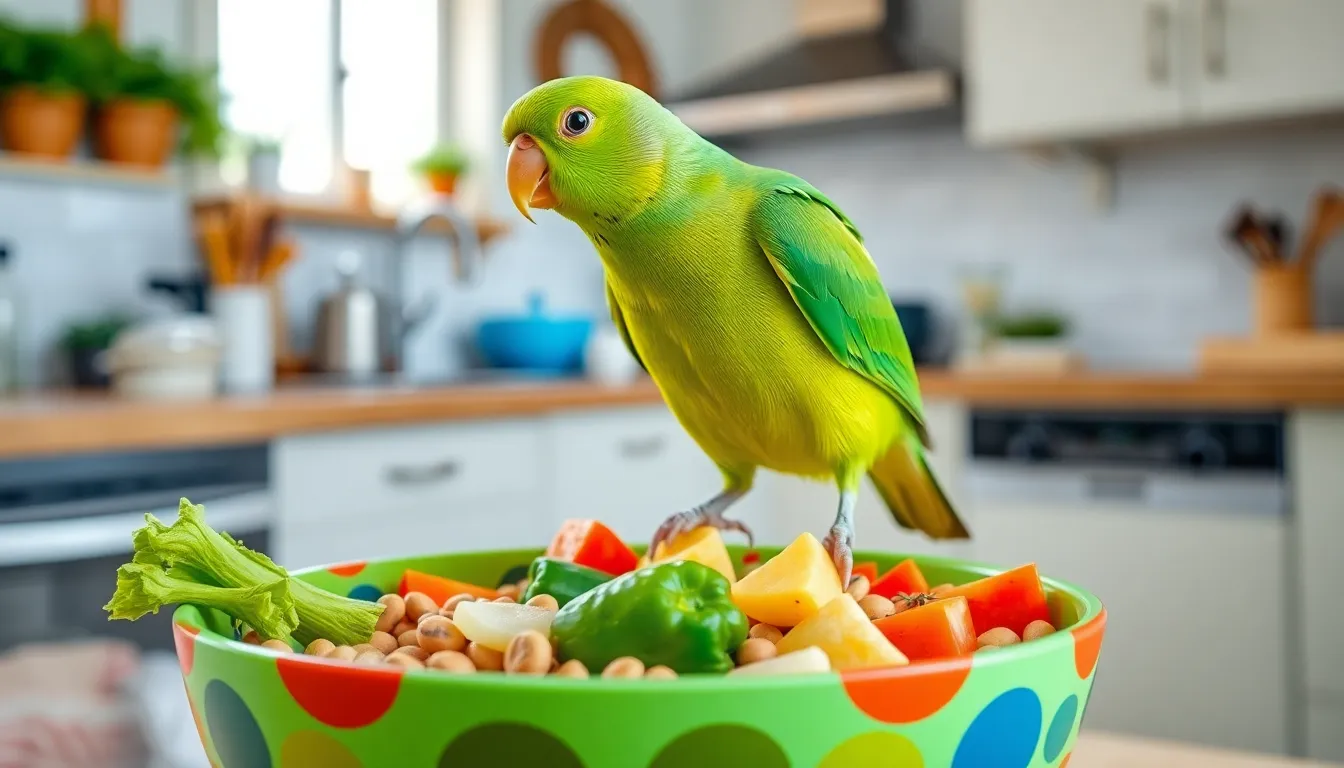
Understanding proper nutrition forms the foundation of parakeet health and longevity. We’ve observed that a balanced diet significantly impacts their vibrant plumage, energy levels, and overall well-being.
Essential Foods and Supplements
High-quality pellets constitute 75% of our parakeets’ daily diet, providing complete nutrition with balanced vitamins and minerals. Seed mixes serve as supplementary food rather than primary nutrition, as they often lack essential nutrients and contain excessive fats.
Fresh vegetables offer vital nutrients and should comprise 20% of their daily intake. We recommend dark leafy greens like spinach, kale, and romaine lettuce alongside colorful options including carrots, bell peppers, broccoli, and sweet potatoes. Fruits provide natural sugars and vitamins but require limitation to 5% of their diet due to high sugar content.
| Food Category | Daily Percentage | Examples |
|---|---|---|
| Pellets | 75% | Harrison’s, Zupreem, Roudybush |
| Vegetables | 20% | Kale, carrots, broccoli, bell peppers |
| Fruits | 5% | Apples, berries, grapes, melon |
Calcium supplements become essential for egg-laying females and growing birds. Cuttlebone and mineral blocks provide natural calcium sources, while vitamin D3 supplements support calcium absorption in indoor parakeets with limited sunlight exposure.
Fresh, clean water must remain available constantly, with daily changes preventing bacterial growth. Water dishes require thorough cleaning every 24 hours to maintain optimal hygiene standards.
Foods to Avoid
Chocolate contains theobromine, which proves toxic to parakeets and can cause seizures or death even in small quantities. Avocado contains persin, a compound that damages parakeet heart muscles and respiratory systems.
Caffeine from coffee, tea, or soda creates cardiac problems and hyperactivity in parakeets. Salt in processed foods leads to kidney damage and dehydration, making human snacks particularly dangerous.
Garlic and onions contain compounds that destroy red blood cells, causing anemia in parakeets. Apple seeds, cherry pits, and peach pits release cyanide when digested, creating potential poisoning risks.
Alcohol affects parakeets’ nervous systems even in microscopic amounts, causing coordination problems and organ failure. Fried foods and items high in fat content cause liver disease and obesity in these small birds.
Dairy products create digestive issues since parakeets lack lactase enzymes needed to process milk-based foods. Processed foods with artificial colors, preservatives, or sugar substitutes disrupt their natural digestive processes and nutritional balance.
Human foods containing xylitol, commonly found in sugar-free gum and candies, cause rapid blood sugar drops and liver failure in parakeets.
Health and Veterinary Care
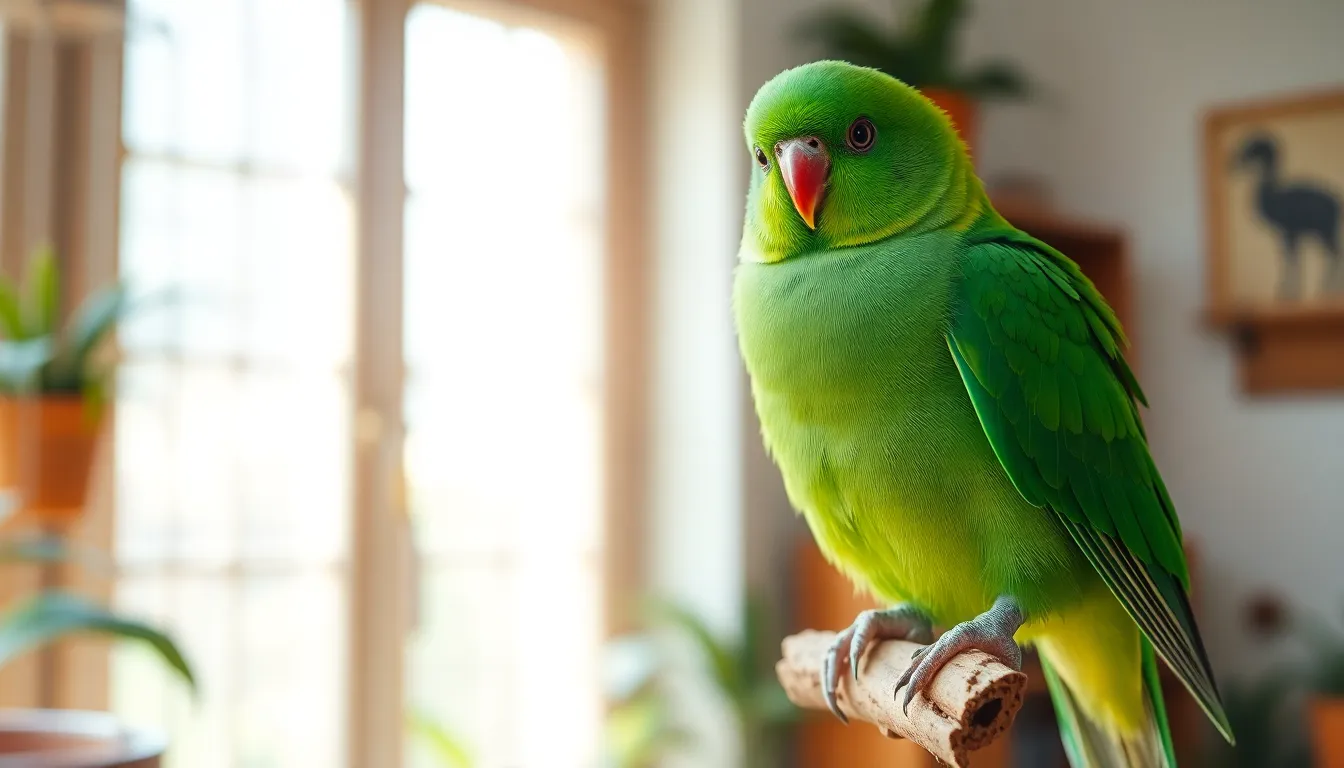
Regular veterinary care forms the foundation of parakeet wellness and significantly extends their lifespan. Proactive health monitoring enables early detection of issues that could otherwise become life-threatening conditions.
Common Health Issues
Respiratory infections represent the most frequent health concern affecting parakeets in captivity. Symptoms include difficulty breathing, tail bobbing, and discharge from nostrils or eyes. Bacterial and viral infections often develop when birds experience stress, poor air quality, or temperature fluctuations.
Feather plucking behaviors indicate underlying physical or psychological distress in parakeets. Nutritional deficiencies, boredom, hormonal imbalances, and skin irritations commonly trigger this destructive behavior. Environmental factors such as inadequate lighting or social isolation frequently contribute to plucking habits.
Egg binding affects female parakeets when eggs become lodged in the reproductive tract. Risk factors include inadequate calcium levels, obesity, stress, and first-time laying. Emergency veterinary intervention becomes necessary when females show signs of straining, lethargy, or abdominal swelling.
Crop stasis occurs when food fails to move properly through the digestive system. Young birds and those with infections face higher risks of developing this condition. Immediate veterinary attention prevents potentially fatal complications.
Liver disease develops gradually in parakeets consuming high-fat diets or exposed to toxins. Seeds comprising more than 25% of daily diet intake increase liver problems significantly. Early detection through regular blood work improves treatment outcomes.
Signs of a Healthy Parakeet Bird
Active engagement throughout the day characterizes healthy parakeets who climb, play, and vocalize regularly. Birds displaying normal behavior patterns perch comfortably on one foot while resting and maintain upright postures when alert.
Bright eyes without discharge indicate good health in parakeets. Clear, round pupils that respond to light changes and alert expressions signal proper neurological function. Healthy birds exhibit curious behaviors and track movement around their environment.
Smooth feathers lying flat against the body demonstrate optimal physical condition. Preening behaviors maintain feather quality and indicate normal flexibility and comfort levels. Healthy parakeets display vibrant colors matching their species-exact patterns.
Regular eating and drinking habits reflect stable health in captive parakeets. Normal appetite includes consuming approximately 1.5 to 2 teaspoons of food daily for budgerigars. Consistent weight maintenance within 5% of baseline measurements suggests proper nutritional status.
Normal breathing patterns remain quiet and unlabored in healthy birds. Respiratory rates of 25 to 35 breaths per minute at rest indicate proper lung function. Healthy parakeets vocalize clearly without wheezing or clicking sounds during communication.
| Health Indicator | Normal Range | Frequency of Assessment |
|---|---|---|
| Body weight | Species baseline ±5% | Weekly |
| Food consumption | 1.5-2 tsp daily (budgies) | Daily monitoring |
| Respiratory rate | 25-35 breaths/minute | During handling |
| Vocalization | Clear, species-typical | Daily observation |
| Preening frequency | Multiple times daily | Daily observation |
Training and Bonding With Your Parakeet Bird
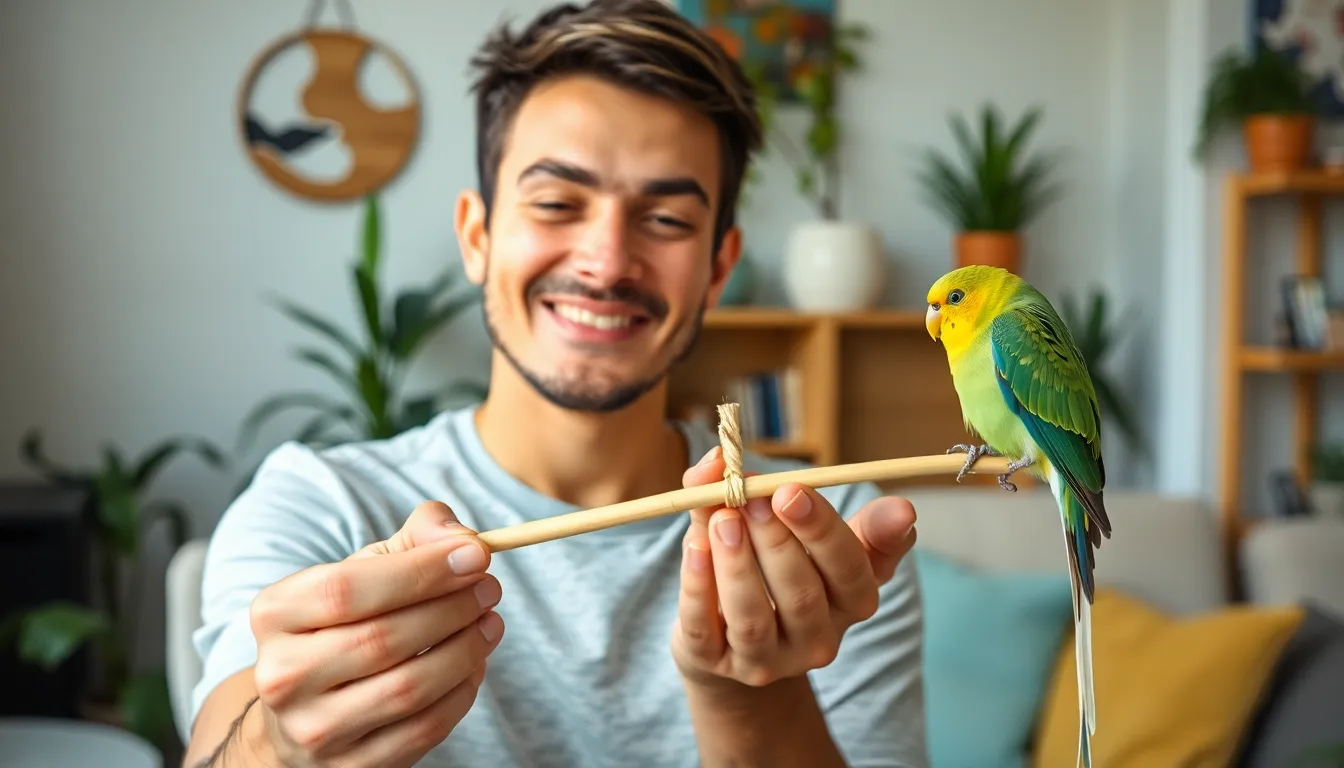
Training your parakeet bird creates a foundation for lifelong companionship and mental stimulation. We can develop strong relationships with these intelligent birds through consistent techniques and patience.
Basic Training Techniques
Target training serves as the fundamental skill for parakeet education. We place a wooden dowel or training stick near our bird’s beak and reward contact with millet spray or sunflower seeds. Most parakeets learn this behavior within 3 to 5 training sessions of 10 minutes each.
Step-up training builds on target skills by teaching our parakeet to step onto our finger or hand. We present our index finger parallel to their perch at chest level and use the command “step up” in a calm voice. Budgerigars typically master this technique in 7 to 14 days with daily practice.
Recall training develops when we establish trust through consistent step-up responses. We start with short distances of 2 to 3 feet and gradually increase to 10 feet or more. Indian ringneck parakeets excel at this training due to their strong flight capabilities and problem-solving intelligence.
Verbal cue association connects exact words with actions or objects. We repeat simple phrases like “good bird” during positive interactions and “no” during unwanted behaviors. Alexandrine parakeets can learn 30 to 50 distinct verbal cues with regular practice sessions.
Training sessions work best when limited to 10 to 15 minutes twice daily. We schedule these sessions before meal times when our parakeet shows increased motivation for food rewards. Consistency in timing and commands accelerates learning by 40 to 60 percent compared to irregular training schedules.
Building Trust and Relationships
Initial bonding begins with quiet observation periods where we sit near our parakeet’s cage for 15 to 20 minutes daily. We speak softly and avoid sudden movements that might startle our bird. Most parakeets show curiosity about their caregiver within the first week of consistent interaction.
Hand feeding strengthens our relationship when we offer favorite treats like spray millet through cage bars. We extend our hand slowly and allow our parakeet to approach at their own pace. Monk parakeets often accept hand feeding within 5 to 7 days due to their naturally social disposition.
Out-of-cage bonding occurs when our parakeet demonstrates comfortable step-up behavior and shows no flight panic responses. We create bird-safe rooms by removing ceiling fans, covering mirrors, and securing windows. Supervised out-of-cage time of 30 to 60 minutes daily significantly improves our parakeet’s mental health and human bond.
Routine establishment builds security through predictable daily activities. We maintain consistent feeding times, cage cleaning schedules, and interaction periods. Parakeets thrive on routine and show reduced stress behaviors when we follow regular schedules.
Body language recognition helps us understand our parakeet’s emotional state and communication attempts. Relaxed birds display smooth feathers, one foot tucked up while perching, and gentle head movements. Stressed parakeets show fluffed feathers, rapid breathing, and repetitive pacing behaviors.
Vocalization bonding develops when we respond to our parakeet’s natural calls with gentle whistles or repeated phrases. We can strengthen our relationship by learning to recognize their different vocalizations for hunger, excitement, and contentment. Budgerigars produce over 20 distinct calls that we can learn to interpret and respond to appropriately.
Pros and Cons of Owning a Parakeet Bird
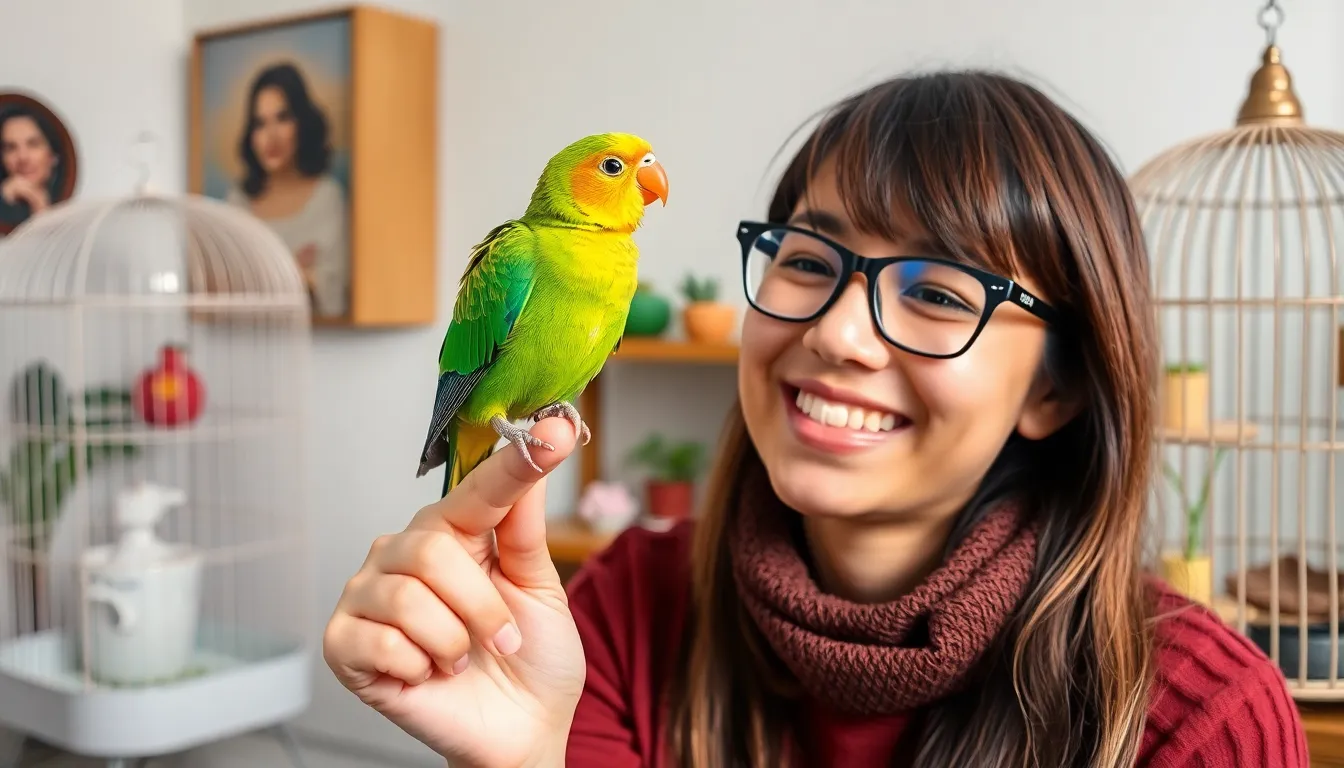
Parakeet ownership presents both rewarding experiences and important responsibilities that potential bird parents must carefully consider.
Advantages of Parakeet Companionship
Social Interaction and Entertainment
Parakeets provide constant companionship through their naturally captivating personalities and interactive behaviors. These birds form strong bonds with their human caregivers while displaying remarkable intelligence through problem-solving activities and learned behaviors. Daily interaction sessions create meaningful relationships that can last 5 to 30 years depending on the species.
Vocal Abilities and Communication
Many parakeet species master impressive vocabularies with consistent training and social interaction. Budgerigars learn 20+ distinct words while larger species like Alexandrines develop vocabularies exceeding 100 words. Their natural vocalizations create lively household atmospheres through chirping, singing, and mimicked sounds throughout the day.
Manageable Size and Space Requirements
Most parakeet species adapt well to apartment living with appropriate cage dimensions. Budgerigars thrive in 30″×18″×18″ enclosures while larger species require 36″×24″×36″ minimum spaces. Their compact size makes handling easier compared to larger parrot species while still providing meaningful interaction opportunities.
Relatively Lower Maintenance Costs
Daily food expenses remain minimal with quality pellets costing $15-25 monthly per bird. Veterinary care costs less than larger parrot species while basic supplies like perches, toys, and cage accessories require modest initial investments of $200-400 for complete setups.
Challenges of Parakeet Ownership
Daily Time Commitments
Parakeets require 2-4 hours of daily interaction including feeding, training, socialization, and supervised out-of-cage time. Their social nature demands consistent attention schedules that can’t be easily postponed or skipped without affecting their mental health and behavioral development.
Noise Levels and Vocalization Patterns
These birds vocalize most actively during dawn and dusk hours with natural calling behaviors that can disturb neighbors in close living situations. Their vocalizations reach 65-75 decibels during peak activity periods while maintaining steady chatter throughout daylight hours.
Long-term Financial Responsibilities
Veterinary expenses accumulate over lifespans spanning decades with routine checkups costing $75-150 annually. Emergency medical treatments range from $200-800 per incident while specialized diets, replacement toys, and cage upgrades create ongoing expenses throughout their lives.
Specialized Care Requirements
Temperature maintenance between 65-80°F requires climate control considerations while exact humidity levels of 50-60% may need monitoring equipment. Their sensitive respiratory systems demand excellent air quality with restrictions on household cleaners, candles, and aerosols that could prove fatal to these delicate birds.
Social Dependency Concerns
Single parakeets often develop behavioral issues including excessive screaming, feather plucking, and aggression when their social needs aren’t adequately met. Vacation care arrangements become complicated as these birds don’t adapt well to boarding facilities and require experienced pet sitters familiar with their exact needs.
Cost of Parakeet Bird Ownership
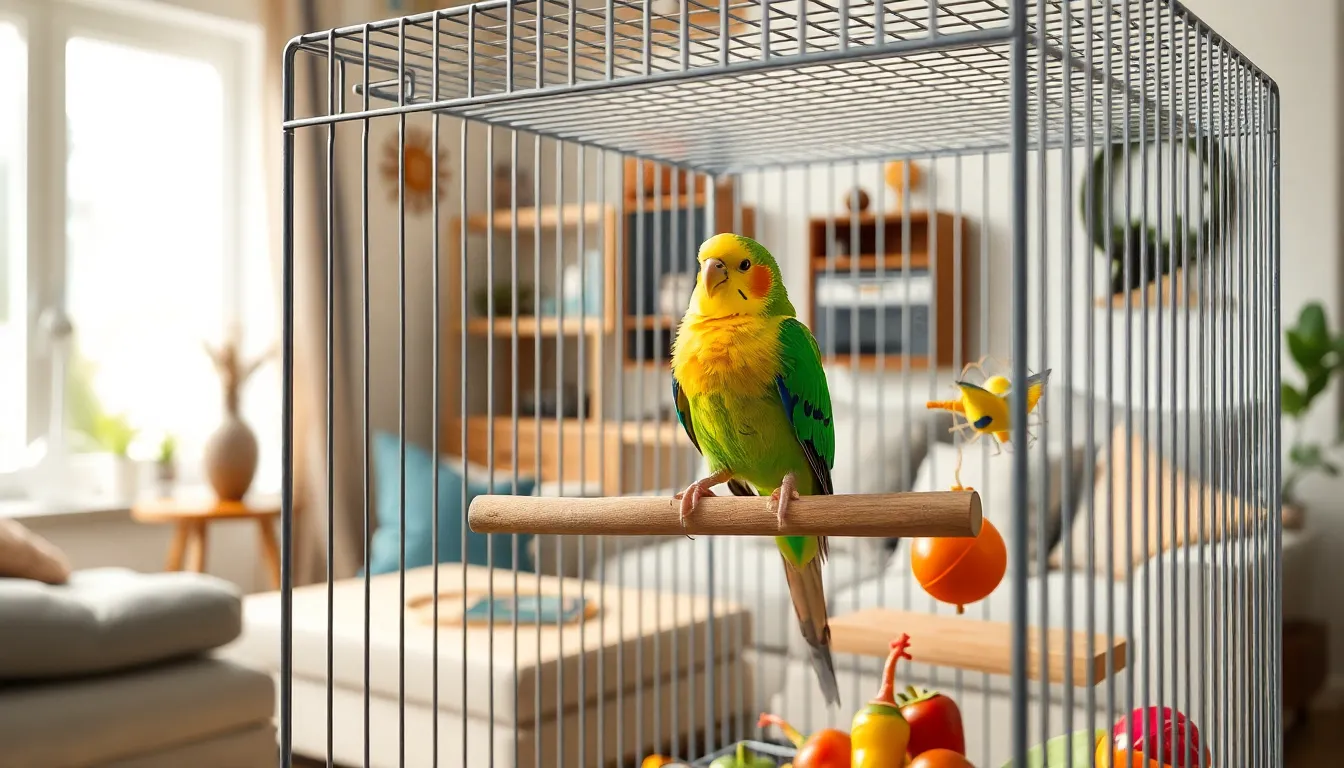
Understanding the financial commitment of parakeet ownership helps us make informed decisions about welcoming these vibrant birds into our homes. Initial setup costs vary significantly based on species selection and housing quality preferences.
Initial Setup Costs
Purchasing a parakeet ranges from $15 to $800 depending on species and breeding quality. Budgerigars typically cost between $15-50 at pet stores while specialty breeds like Alexandrine parakeets command prices of $300-800 from reputable breeders. Cages represent the largest upfront expense after the bird itself.
| Item | Budget Range | Premium Range |
|---|---|---|
| Parakeet Purchase | $15-50 | $300-800 |
| Cage | $80-150 | $200-500 |
| Perches | $20-40 | $50-100 |
| Food/Water Dishes | $15-25 | $30-60 |
| Initial Toys | $25-50 | $75-150 |
| Total Initial Cost | $155-315 | $655-1,610 |
Quality cages measuring 24x16x32 inches minimum cost $80-150 for basic models while premium flight cages reach $200-500. Perches made from natural wood branches cost $20-40 for starter sets compared to $50-100 for specialized perch systems with varying diameters and textures.
Monthly Operating Expenses
Food costs remain the most predictable monthly expense for parakeet care. High quality pellets cost $8-15 monthly for a single budgerigar while larger species consume $15-25 worth of pellets monthly. Fresh vegetables and limited fruits add another $10-20 to monthly grocery expenses.
Bedding materials like paper liners or wood shavings cost $5-10 monthly depending on cage cleaning frequency. Toy rotation maintains mental stimulation with new items costing $10-25 monthly for interactive and destructible options.
Annual Healthcare Costs
Veterinary care represents a important portion of parakeet ownership expenses throughout their lifetime. Annual wellness examinations cost $50-150 at avian veterinary clinics while emergency visits range from $200-600 depending on diagnostic requirements and treatment complexity.
Routine blood work and fecal examinations add $75-200 to annual healthcare costs. Preventive treatments like wing clipping and nail trimming cost $20-40 per session when performed by veterinary professionals.
Unexpected Medical Expenses
Emergency medical situations create the highest financial impact for parakeet owners. Respiratory infections require immediate treatment costing $150-400 including diagnostics and medications. Egg binding in female parakeets demands emergency intervention with costs reaching $300-800 for successful treatment.
Chronic conditions like liver disease or persistent feather plucking require ongoing veterinary management with monthly medication costs of $30-100. Surgical procedures for crop stasis or internal injuries range from $500-1,500 at specialized avian hospitals.
Long Term Financial Planning
Parakeets live 5-30 years depending on species which creates substantial long term financial commitments. Budgerigars accumulate total lifetime costs of $1,500-3,000 while larger species like Alexandrine parakeets reach $5,000-10,000 over their extended lifespans.
Cage replacement becomes necessary every 5-10 years as wear patterns develop and safety standards evolve. Premium cages maintain structural integrity longer than budget models reducing replacement frequency and long term costs.
Setting aside $50-100 monthly for parakeet expenses creates emergency funds for unexpected veterinary bills and equipment replacement needs. Insurance policies specifically designed for exotic birds offer coverage options starting at $10-25 monthly premiums.
Conclusion
Parakeets represent one of nature’s most rewarding avian companions when we understand their needs and commit to their care. These remarkable birds offer years of friendship intelligence and entertainment that can enrich our lives in countless ways.
Success with parakeet ownership comes down to preparation and dedication. We’ve covered everything from species selection to long-term financial planning because informed decisions lead to happier birds and more satisfied owners.
Whether you’re drawn to their vibrant personalities or impressive learning abilities parakeets can make wonderful additions to the right households. The key lies in honestly assessing our ability to meet their social physical and emotional needs for years to come.
With proper care and commitment these feathered friends will reward us with their unique personalities and create lasting memories that make every investment worthwhile.
Frequently Asked Questions
What exactly is a parakeet?
Parakeets are small to medium-sized parrots from the order Psittaciformes, known for their long tail feathers and vibrant plumage. They originate from tropical and subtropical regions across Australia, South America, Africa, and Asia. There are over 115 species of parakeets, with budgerigars being the most common species kept in captivity.
How long do parakeets typically live?
Parakeet lifespan varies significantly by species. Budgerigars typically live 5 to 10 years, while larger species like Alexandrine parakeets can reach 20 to 30 years with proper care. Proper nutrition, veterinary care, and a suitable environment are crucial factors that influence their longevity and overall health.
What size cage does a parakeet need?
Cage size requirements vary by species. Budgerigars need a minimum cage size of 18″×18″×18″, while larger species require more space. The cage should allow for proper perch placement, food and water stations, and enough room for the bird to spread its wings fully and move around comfortably.
What should I feed my parakeet?
A balanced parakeet diet consists of 75% high-quality pellets, 20% fresh vegetables (especially dark leafy greens), and 5% limited fruits. Avoid harmful foods like chocolate, avocado, caffeine, and processed items. Provide fresh water daily and consider calcium supplements for egg-laying females and growing birds.
Are parakeets social birds?
Yes, parakeets are highly social birds that thrive in group environments. They exhibit sophisticated vocalizations with over 20 distinct calls and form strong pair bonds. Single parakeets often view their human caregivers as flock members, but may develop behavioral issues if their social needs aren’t met properly.
Can parakeets learn to talk?
Many parakeet species can learn to mimic human speech, though abilities vary by species. Alexandrine parakeets can master larger vocabularies compared to budgerigars. Their impressive intelligence and learning abilities allow them to retain learned behaviors for months and solve complex problems through training.
How much does it cost to own a parakeet?
Initial setup costs range from $155 to $1,610, depending on species and housing quality. Monthly expenses include food, bedding, and toys. Annual healthcare costs and unexpected medical expenses should also be considered. Lifetime costs can range from $1,500 to $10,000, making financial planning essential.
Do parakeets require special veterinary care?
Yes, parakeets need specialized avian veterinary care. Regular check-ups are essential and can significantly extend their lifespan. Common health issues include respiratory infections, feather plucking, and liver disease. Early detection of symptoms is crucial, so monitor for changes in behavior, eating habits, and physical appearance.
How do I bond with my parakeet?
Building a bond requires patience and consistent interaction. Start with quiet observation, hand feeding, and supervised out-of-cage time. Basic training techniques like target training and step-up training help establish trust. Understanding their body language and vocalizations is essential for strengthening your relationship.
What are the main challenges of parakeet ownership?
Key challenges include daily time commitments for interaction, potential noise levels, long-term financial responsibilities, and specialized care needs. Parakeets are social creatures that require consistent attention and mental stimulation. Their vocal nature and need for companionship make them unsuitable for all living situations.

